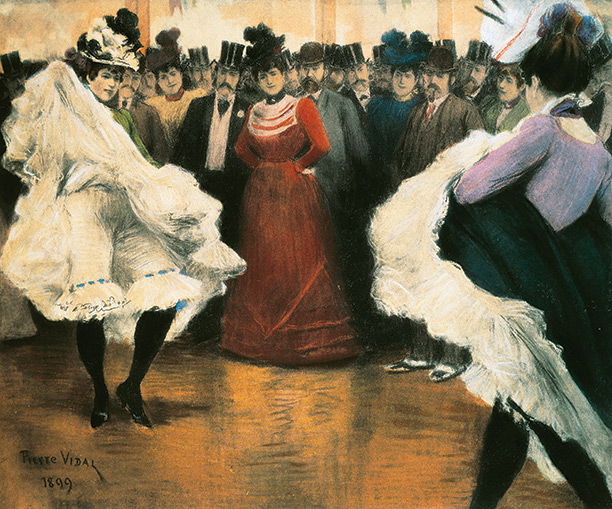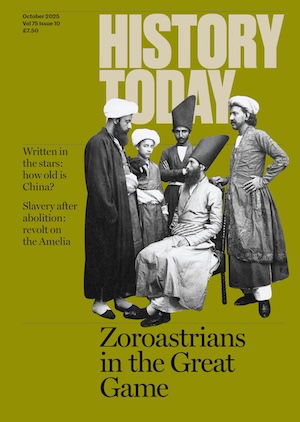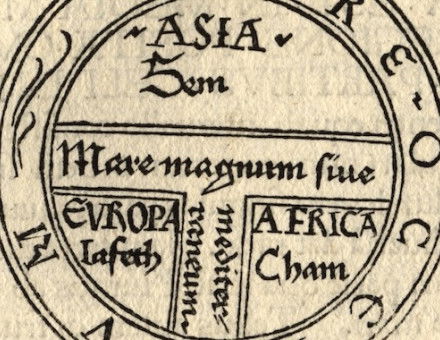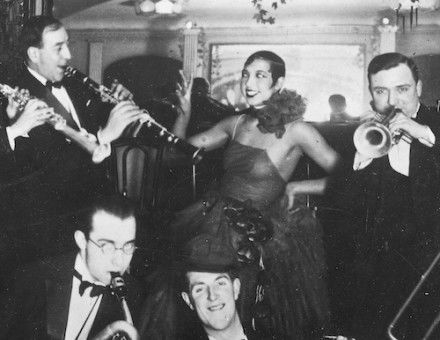From Music Hall to Moulin Rouge: A History of the Cancan
Jonathan Conlin finds a surprising story of Anglo-French exchange behind the frothing petticoats and high kicks of this most Parisian of dances.
 On the evening of October 8th, 1870 the Metropolitan Police sent two undercover officers to sit among the audience at the Alhambra, a music hall on Leicester Square, in the heart of London’s theatre district. For two years the Lord Chamberlain and magistrates responsible for maintaining decency and public order in and around the capital’s theatres had been receiving complaints. A new kind of dance lately arrived from France was outraging some members of the public with its ‘lewd antics and lascivious movements’. Superintendent Dunlop of C Division bought two tickets and ordered Inspector J.E. Perry and Sergeant John Pope to find out what was going on.
On the evening of October 8th, 1870 the Metropolitan Police sent two undercover officers to sit among the audience at the Alhambra, a music hall on Leicester Square, in the heart of London’s theatre district. For two years the Lord Chamberlain and magistrates responsible for maintaining decency and public order in and around the capital’s theatres had been receiving complaints. A new kind of dance lately arrived from France was outraging some members of the public with its ‘lewd antics and lascivious movements’. Superintendent Dunlop of C Division bought two tickets and ordered Inspector J.E. Perry and Sergeant John Pope to find out what was going on.
If the report they submitted later is anything to go by, they did not have a good time:
We beg to report having attended the Alhambra Palace Music Hall on the 8th inst, when the ballet Les Nations was performed, in the which Mdlle. Colonne and troupe (four in all) appeared, and danced the Parisienne quadrille, or ordinary ‘can-can’. Two of them personated men, dressed in bodices and trunks to match, and flesh-coloured hose; the others as females, dressed as ordinary ballet girls, except more of the thigh was visible in consequence of having very scanty drawers. The dance, on the whole, is indecent, especially on the part of one dressed as a female, who raises her foot higher than her head several times towards the public, which was much applauded. There was a large influx of visitors shortly before the ballet commenced, but which was decreased immediately after. The other performances were carried on principally by females dressed as males, but there was nothing objectionable observed.
Surviving programmes allow us to flesh out this po-faced account. Les Nations, or the Grand Cascades was a ‘water ballet and spectacle’ which lasted an hour, from 10.15pm to 11.20pm. Music hall programming at this time emphasised variety and so this ‘ballet’ was more of a series of acts or ‘turns’ than a sustained narrative. The Royal Tycoon’s Private Troupe of Japanese and the marvellous monkeys from the Cirque L’Imperatrice appeared on the programme alongside the objectionable dancers. The Parisian troupe was named after a Mademoiselle Colonna, but, as Perry and Pope acknowledged, the star was the ‘one dressed as a female,’ who performed the highest kicks in her ‘scanty drawers’. Her name was Finette.
Immortalised by 19th-century artists such as Toulouse-Lautrec and Seurat and 20th-century film directors such as Jean Renoir (French Cancan, 1955) and most recently Baz Luhrmann (Moulin Rouge! 2001), the cancan is, like the Eiffel Tower, a universally recognised symbol of Paris. The shocked response of the London authorities to Finette rehearsed well-worn stereotypes of Paris, the dazzling city of sin, opposed to London, the buzzing hive of respectable industry. Londoners could never, surely, have thought up something as voluptuous as the cancan. Four years later the editor of Vanity Fair, Thomas Gibson Bowles, went so far as to claim that ‘the word can-can cannot be translated into English without indecency ... the dance is suggestive of the most indecent acts’.
A closer look at the history of the cancan and its various homes reveals a very different story, a pedigree more complex than the London jeremiads and the Parisian tourist brochures suggest. That is why Perry and Pope’s description seems odd. Although Finette is described as performing the ‘can-can’, it is not the dance we know by that name. Only after coming into contact with skirt dancing in London would cancan develop into the skirt-waving, knicker-flashing extravaganza we all recognise. ‘French cancan’ emerged from a process of Anglo-French, cross-Channel exchange, evolving as performers travelled between the two cities. In addition to revealing something about the history of gender, the entertainment industry and of modernity itself, this story shows how the mutual fascination of Paris and London has influenced both to a greater extent than we imagine.
The cancan emerged in Paris following the 1830 Revolution, a mutation of the chahut. Its name derived from a 16th-century word meaning a din or racket. Both dances were based on the quadrille, a type of country dancing (known as contredanse in France), imported from England in the 18th century. Until 1855 the cancan was very much the people’s dance, usually performed in groups made up of four couples. With the exception of unsuccessful attempts to introduce it to London’s Vauxhall and Cremorne Gardens in 1845 and 1852 respectively, it was not known in England, though Regency bucks did travel to Paris to ‘quadrill it,’ as George Cruikshank demonstrated in a print of 1822.
At this point in its development the kicking element of the cancan was largely reserved for the men, usually artisans or students dancing with their girlfriends or grisettes, working-class mistresses popular with Bohemians, supposedly named after the grey cloth they wore. The dance was performed at one of the 230 bals or ballrooms that operated in Paris in the 1830s, each accommodating between 50 and 300 patrons, a clientele normally restricted to a specific quartier or profession. These were summertime resorts, open to the sky, lit by colourful lanterns and policed by an officer of the garde municipale. For reasons that remain unclear, the cancan was perceived by the authorities as an expression of resistance to the July Monarchy, the constitutional monarchy of Louis-Philippe, which lasted from the July Revolution of 1830 until the 1848 Revolution. The 1831 edition of the police manual advised sergents de ville to order those dancing the chahut or cancan to stop. If they disobeyed they were to be arrested and brought before the magistrate on a public decency charge.
If it was intended as a form of political protest, however, it was a playful form. The cancan was not really a step or dance in the traditional sense, but rather a sort of exaggerated, bow-legged body-popping performed for the admiration of a man’s female partner or the intimidation of rival males. Writing in 1854, Bayle St John called it ‘a violent kind of gymnastics, in which genteel young men kick up their legs, wag their heads, distort their bodies, and scatter their arms, elbows, and hands’. There was no particular time signature or melody associated with it. The first recorded cancan stars were talented amateurs who practised respectable trades by day only to metamorphose into kicking celebrities by night, known by noms de guerre such as Chicard [‘the chic one’] and Brididi. Chicard was a leather merchant named Alexandre Lévêque, Brididi a florist.
After 1855, however, the focus of the dance shifted from amateur to professional, from male to female and, most importantly, from participation to voyeurism. Opened in 1840 and extensively refurbished four years later, the Bal Mabille (located on today’s Avenue Montaigne) played a key role in all these changes, helping several girls kick their way out of the working class. They became celebrities in the full sense of the term, complete with ghosted memoirs. Those of the dancer known as ‘Rigolboche’ appeared in 1860, one of a number characterised by sob-story plots and arrogant put-downs of rivals. Formulaic in the extreme, such books at least had the virtue of being short. ‘What more do you expect?’ writes Rigolboche at the end of hers, ‘I’m only 18!’
These young women performed the cancan solo on the dance floor, starting and stopping apparently at random, rather than forming part of a formal programme arranged beforehand with Mabille’s manager or its orchestra. Once they got going, other dancers would rush to form rings round them, joined by those who had come with no intention of dancing themselves, but rather to admire those who did. Spectators were of a higher social class than dancers and included tourists from London, particularly in 1867, the year of the Paris Exhibition. Their patriotism spurred by such visitors, hack writers who penned pamphlets or memoirs of such bals now began to write about the cancan. They insisted that it was the national dance and began to construct its past, as well as tenuous explanations for why it so suited the French people. ‘The cancan is preeminently French’, explained Paul Mahalin in his Mémoires du Bal Mabille (1864). ‘Among a people like us, as light in spirit as in body the cancan must be and is more of a physical need than a passing sensation, more passion than science – an art.’
Finette, Rigolboche and other female dancers performed the cancan in calf-length skirts, with their legs fully encased in thick satin tights, from their boots right up to their pantalons (trouser-like undergarments). There was no flashing of petticoats, garters or suspenders. No one lifted or waved their skirts around. The story of the cancan might have stopped there, around 1870. An early form of break-dancing born in Parisian bals publics, refined by a few flexible amateurs, male as well as female. That it did not was thanks to a British dancer, Kate Vaughan, inventor of a new type of dance known as skirt dancing and, crucially, the first performer to flash lace petticoats on stage. Although Vaughan’s own tour to Paris in February 1876 was not a success (she was booed off the stage), Parisian stars like Finette and especially the slightly younger generation of La Goulue (the Glutton) and Grille d’Egout (Sewer Grate) copied Vaughan’s dress and skirt manipulation. Combining it with the high kicks of gymnastic cancan they in turn created ‘French cancan’.
Vaughan’s style of dancing consisted of performing traditional dance figures, usually the waltz, with both hands clutching and moving her skirt in time to the music. Under her skirt Vaughan wore several lace-fringed petticoats with gold-spangled black tights beneath. She did not lift her skirt very high, however, nor did she perform high-kicks. Her somewhat detached or possibly demure expression seemed to contrast with a suppressed and risqué alter ego. While Parisian cancan dancers described cancan as a kind of involuntary spasm that overwhelmed their bodies, in Vaughan’s case the conflict was externalised. Audiences were hooked not because Vaughan was lifting her skirts, but because she seemed to be struggling unsuccessfully to keep them down. As the title of her first skirt dancing routine, Ain’t She Very Shy?, indicates, Vaughan and her managers were well aware of this erotic teasing quality, which drew many admirers. The art critic John Ruskin and the Pre-Raphaelite painter Edward Burne-Jones fell into each other’s arms when they discovered their shared appreciation of Vaughan.
By prosecuting impresarios who staged cancan, London magistrates felt themselves to be defending England from foreign immorality, with Finette identified as a Pied Piper leading impressionable youth ‘to destruction’. In their defence managers argued that the cancan formed part of a legitimate entertainment industry that gave employment to hundreds, including young female performers who would be thrown onto the street (where, it was hinted, they would take up prostitution), if their employers lost their licenses, as the Alhambra did in 1870.
Prosecutions partly turned on the question of whether the cancan was a dance (and therefore required the venue to be licensed for dancing) or, as one witness put it, ‘more of contortion business’. A lawyer representing another London music hall, the Cambridge, argued that cancan was capering rather than dancing, only to have the judge point out that ‘to caper’ was to ‘dance as if he were a goat’. This rather flummoxed the defence. ‘Judge and Jury’ shows had been a popular form of entertainment in the 1840s and those present in the courtroom must have struggled to take the case entirely seriously, as witness after witness gave up trying to put the cancan into words and began miming it in the witness box, to loud laughter from all present. In the Cambridge’s case the court ruled that the cancan was not a dance. It was ludicrous, not licentious.
By the 1880s things had changed. Vaughan’s skirt dancing inspired the generation of Parisian dancers that followed Finette to dress differently, to grab hold of their skirts and wave them around. Photographs from the early 1880s of La Goulue and Grille d’Egout are strikingly different from those taken two decades before. The dancers raise their skirts to reveal a much more tantalising display of white petticoats or jupons. Their legs are encased in black silk tights but are only visible up to just below the knee, where the white frilly pantalons begin. Though it is hard to imagine the cancan without thinking of suspender belts, here they are absent.
The cancan was now fully professional and the easy mingling of the Parisian bals had ended, as the Mabille and other resorts closed. In May 1869 the Folies Bergères opened in a former furniture warehouse on the Rue Richer. Although it initially struggled to make a profit, in the 1880s it was transformed into a London-style music hall, complete with a promenade. Here audience members could mingle and order drinks while keeping one eye on what was happening onstage, as they do in Edouard Manet’s famous painting, A Bar at the Folies-Bergères (1882). In October 1889 the Moulin Rouge was opened by Charles Zidler and Joseph Oller on a site at the foot of the butte Montmartre, previously occupied by a bal, La Reine Blanche. Here, as Henri de Toulouse-Lautrec demonstrated in another classic image, The Englishman at the Moulin Rouge (1892), the English flavour of the entertainment as well as the presence of English tourists was obvious.
Back in London music hall singers did their bit to celebrate Paris as the perfect destination for a jaunt, a destination they christened ‘Gay Paree’. Charles Godfrey had a hit in 1891 with a song of the same name, composed by Edward Jonghmans to words by Richard Morton:
Through Gay Par-ee! Gay Par-ee!
Four silly Britishers out upon the spree!
Promenading - Boulevarding,
Simply on the spree!
Dainty damsels, tasty ma’amsells,
May I kiss you? – Oui!
I and Tom, and Dick, and Harry,
Out in Par-ee, good old Par-ee! Gay Par-ee!
In later verses the four visitors start a fight, spending a night in jail before being sent ‘Back again to London town!’, apparently none the worse for their adventure.
The cheery violence of ‘Gay Paree’ songs was characteristic of the 1890s. Songs like J. H. Milburn’s ‘Come Along Boys, Let’s Make a Noise’ came close to celebrating hooliganism as they told of ‘mashers’ rampaging through the city streets. Parisian boulevards were made, it seemed, for English visitors ‘looking for something choice,’ that is, trawling for prostitutes. Femmes fatales, flânerie, dodgy French and (mock) remorse all appear in ‘Gay Paree’ songs. His mind reeling from ‘Those fancy liquors/And sky-high kickers’, the hero of the song ‘I’ve Been To Gay Paree’ asks himself ‘Why did I do it,/I knew I’d rue it’.
In May 1891 the French gentleman’s magazine Gil Blas issued a supplement devoted to ‘Eccentricities of dance,’ written by the bibliophile and collector Eugène Rodrigues-Henriques. Rodrigues-Henriques gave a heady description of the cancan at its zenith, as danced by Louise Weber, La Goulue, a dance as collective orgasm. He described how that ‘piece of pink flesh’ above her garter ‘spurts molten steel over the panting spectators’ until, eventually, ‘a dark stain indicates that most intimate of efflorescences, and a similar thrill seizes the watching men and women’.
La Goulue’s partner, Grille d’Egout, saw the same dance very differently, providing a glimpse of the mundane reality that lay behind those curtains of lace, the world where dancers had to save up their meagre wages to keep themselves in the expensive undergarments that were gradually eclipsing their individuality. Asked by Gil Blas to describe how she saw the cancan, Grille d’Egout wrote her own article. While she conceded that ‘pretty knickers’ were ‘indispensable,’ Grille d’Egout insisted that she never danced ‘without first attaching the bottom edge of my pantalons to my stockings with pins. Women who show their flesh, that’s disgusting’. Although there is some photographic evidence that La Goulue did reveal a ‘patch of skin’, it seems that in fact this was rare before 1914 and certainly before 1900. ‘Sure, they call me Grille d’Egout – I’m no duchess –’, her article continues, ‘but I don’t like scandalous things – I’m not some kind of lout, oh, no.’
The success of ‘le music hall’ led to fears that it was eclipsing the style of music and performance found at cabarets and cafés-concerts, the intimate summertime resorts in which bohemians mingled with the working class. As early as the 1880s cabaret had become a self-consciously counter-cultural alternative to ‘le music hall’, which it saw as overly slick, commercial and touristy. This parting of the ways drew a line between chanson (that genre of song later associated with Édith Piaf) and variety. It arguably condemned both to a sort of living death. Rather than spawning new developments, the combative performance style of the cabaret artist Aristide Bruant was carefully protected as a more ‘genuine’ Parisian art form than music hall. To a younger generation music hall was commercial, but no less fascinating for it. On his arrival in Paris in 1900 Picasso initially haunted the Lapin Agile cabaret, but soon abandoned it for the Olympia music hall.
By 1900 the cancan celebrity was on her last legs. Solo performers or small troupes of two or four had been eclipsed by the arrival of larger troupes who would make cancan synonymous with rictus smiles and chorus-line monotony. In the 1830s amateur cancan dancers had celebrated their steps as reflections of their own individuality. Unfortunately the tendency of journalists as well as professionals like Rigolboche to describe their cancan in terms of hysteria, hypnosis or electrification made the cancan seem more like a case of individual dancers ‘out of control’. New British and American troupes, such as the Tiller Girls, made the cancan seem less of a celebration of joie de vivre and individuality than a line of runaway automata.
Alongside a shift from participation to voyeurism and from individual expression to mechanisation, cancan also reveals something important about the construction of patriotic myths and their commercialisation. Moral stereotypes and a commercial eye for the ‘exotic’ encouraged Parisians and Londoners to deny that they had learned anything from each other. For today’s Parisians the cancan is French, but not français. The label is, apparently, applied by and for non-Parisians. Thus London and Paris blamed each other: Paris was at fault for misdirecting London’s youth with its ‘harlots’ quadrille’, London for turning the French ‘national dance’ into tourist schlock. They were both right. In just 50 years they had built an invisible city, one that was as seductive, glamorous and romantic as it was mechanised, commercial and high-tech. Paris Qui Danse – ‘Gay Paree’.




